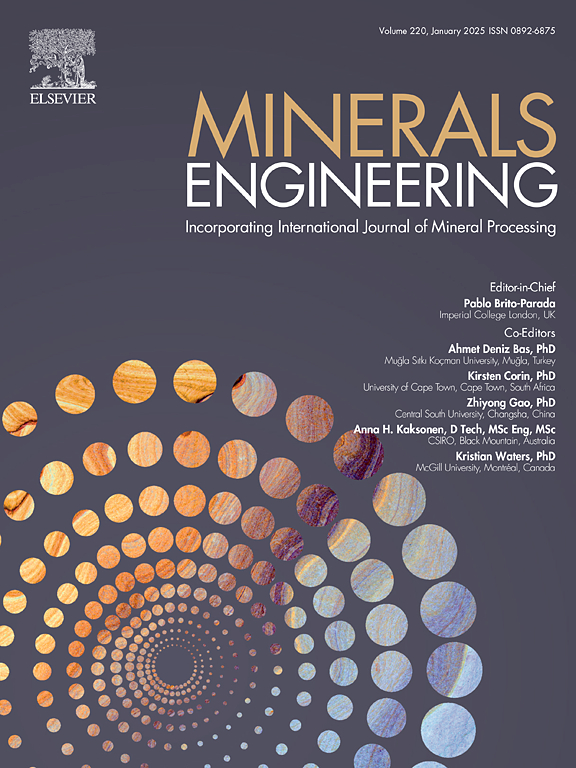磁流体耦合高梯度磁选回收超细钛铁矿的清洁短流程
IF 4.9
2区 工程技术
Q1 ENGINEERING, CHEMICAL
引用次数: 0
摘要
攀西钒钛磁铁矿床超细钛铁矿物(- 0.019 mm)一般采用水力分级分选,排至尾矿中,严重影响后续浮选工艺,造成钛资源的极大浪费。采用高梯度磁选-浮选相结合的方法回收超细钛铁矿,存在流程长、药剂用量大、污染环境等缺点。采用高梯度磁选耦合磁流体法(HGMSCMF)回收攀西地区超细钛铁矿。系统研究了MnCl2浓度(流体磁化率)、外加感应强度和脉动频率对HGMSCMF中TiO2品位和磁性产物回收率的影响。在MnCl2浓度为40%、感应强度为0.8 T、脉动频率为300 r/min的最佳条件下,经过三级HGMSCMF处理,TiO2回收率为43.58%,可获得检测TiO2含量为46.09%的磁精矿。采用数值模拟方法对钛铁矿和钛辉矿颗粒进行了吸附,并在此基础上研究了吸附钛铁矿颗粒比例随MnCl2浓度的变化规律及施加诱导作用。理论结果与实验结果吻合较好,表明HGMSCMF对矿物粒度具有较好的适应性。研究了一种含磁流体循环的超细钛铁矿连续回收清洁短流程。HGMSCMF在超细钛铁矿及其他难选弱磁性矿物的清洁高效利用方面具有很大的优势和应用前景。本文章由计算机程序翻译,如有差异,请以英文原文为准。
Clean and short flowsheet of recovering ultrafine ilmenite by high gradient magnetic separation coupling with magnetic fluid
Ultrafine ilmenite minerals (−0.019 mm) in vanadic titanomagnetite ore deposit in Panxi area of China were generally separated by hydraulic classification and discharged into tailings as these fine minerals will severely deteriorate subsequent flotation process, resulting in a great waste of titanium resources. Methods combining high gradient magnetic separation (HGMS) followed by flotation were usually developed for recovering ultrafine ilmenite, which commonly had defects of long flowsheet, high reagent consumption and environmental pollution. In this study, high gradient magnetic separation coupling with magnetic fluid (HGMSCMF) was adopted to recover ultrafine ilmenite in Panxi area. Effect of MnCl2 concentration (magnetic susceptibility of fluid), applied induction and pulsating frequency on TiO2 grade and recovery of magnetic products in HGMSCMF were systematically investigated. Under optimal conditions of MnCl2 concentration 40 %, applied induction 0.8 T and pulsating frequency 300 r/min, magnetic concentrate assaying 46.09 % TiO2 could be obtained under TiO2 recovery of 43.58 % through three stages of HGMSCMF. Numerical simulation of capture of ilmenite and titanaugite particles by matrices were conducted, based on which variation of ratio of captured ilmenite particles with MnCl2 concentration and applied induction were studied. Theoretical results corresponded well with experimental results and indicated good adaptability of HGMSCMF to mineral particle size. A clean and short flowsheet incorporating recycling of magnetic fluids for continuous recovery of ultrafine ilmenite was developed. HGMSCMF presented great superiority and application prospect in cleaner and efficient utilization of ultrafine ilmenite, as well as other refractory weakly magnetic minerals.
求助全文
通过发布文献求助,成功后即可免费获取论文全文。
去求助
来源期刊

Minerals Engineering
工程技术-工程:化工
CiteScore
8.70
自引率
18.80%
发文量
519
审稿时长
81 days
期刊介绍:
The purpose of the journal is to provide for the rapid publication of topical papers featuring the latest developments in the allied fields of mineral processing and extractive metallurgy. Its wide ranging coverage of research and practical (operating) topics includes physical separation methods, such as comminution, flotation concentration and dewatering, chemical methods such as bio-, hydro-, and electro-metallurgy, analytical techniques, process control, simulation and instrumentation, and mineralogical aspects of processing. Environmental issues, particularly those pertaining to sustainable development, will also be strongly covered.
 求助内容:
求助内容: 应助结果提醒方式:
应助结果提醒方式:


